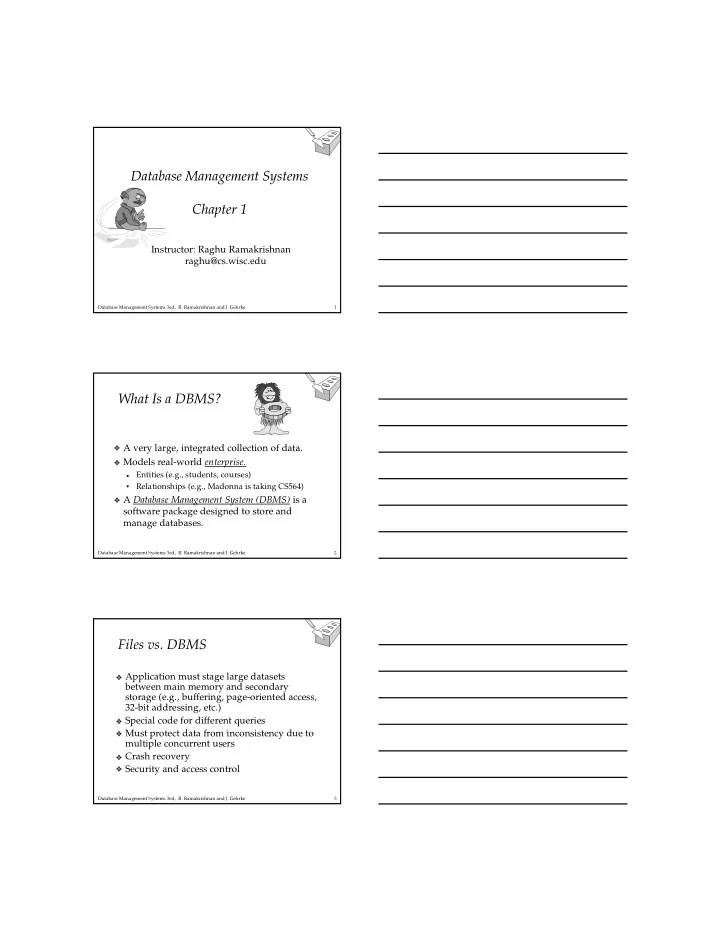

� � � � ✁ ✁ � � � � Database�Management�Systems Chapter�1 Instructor: Raghu�Ramakrishnan raghu@cs.wisc.edu Database�Management�Systems�3ed,��R. Ramakrishnan and�J.�Gehrke 1 What�Is�a�DBMS? A�very�large,�integrated�collection�of�data. Models�real-world� enterprise. Entities�(e.g.,�students,�courses) Relationships�(e.g.,�Madonna�is�taking�CS564) A� Database�Management�System�(DBMS) is�a� software�package�designed�to�store�and� manage�databases. Database�Management�Systems�3ed,��R. Ramakrishnan and�J.�Gehrke 2 Files�vs.�DBMS Application�must�stage�large�datasets� between�main�memory�and�secondary� storage�(e.g.,�buffering,�page-oriented�access,� 32-bit�addressing,�etc.) Special�code�for�different�queries Must�protect�data�from�inconsistency�due�to� multiple�concurrent�users Crash�recovery Security�and�access�control Database�Management�Systems�3ed,��R. Ramakrishnan and�J.�Gehrke 3
� ✁ ✁ � � � ✁ ✁ � ✁ ✁ ✁ � � � � � � Why�Use�a�DBMS? Data�independence�and�efficient�access. Reduced�application�development�time. Data�integrity�and�security. Uniform�data�administration. Concurrent�access,�recovery�from�crashes. Database�Management�Systems�3ed,��R. Ramakrishnan and�J.�Gehrke 4 ? Why�Study�Databases?? Shift�from� computation to� information at�the�“low�end”:�scramble�to webspace (a�mess!) at�the�“high�end”:�scientific�applications Datasets�increasing�in�diversity�and�volume.�� Digital�libraries,�interactive�video,�Human� Genome�project,�EOS�project�� ...��need�for�DBMS�exploding DBMS�encompasses�most�of�CS OS,�languages,�theory,�“A”I,��multimedia,�logic Database�Management�Systems�3ed,��R. Ramakrishnan and�J.�Gehrke 5 Data�Models A� data�model is�a�collection�of�concepts�for� describing�data. A schema is�a�description�of�a�particular� collection�of�data,�using�the�a�given�data� model. The� relational�model�of�data is�the�most�widely� used�model�today. Main�concept:�� relation ,�basically�a�table�with�rows� and�columns. Every�relation�has�a� schema ,�which�describes�the� columns,�or�fields. Database�Management�Systems�3ed,��R. Ramakrishnan and�J.�Gehrke 6
✁ � ✁ � ✁ � ✁ ✁ ✁ ✁ ✁ � � ✁ � � Levels�of�Abstraction Many� views ,�single� View�1 View�2 View�3 conceptual�(logical)�schema and� physical�schema . Conceptual�Schema Views�describe�how�users� see�the�data.���������������������������������������� Physical�Schema Conceptual�schema�defines� logical�structure Physical�schema�describes� the�files�and�indexes�used. * Schemas�are�defined�using�DDL;�data�is�modified/queried�using�DML . Database�Management�Systems�3ed,��R. Ramakrishnan and�J.�Gehrke 7 Example:�University�Database Conceptual�schema:������������������ Students(sid:�string,�name:�string,�login:�string,� age:�integer, gpa:real) Courses(cid:�string, cname:string,�credits:integer)� Enrolled(sid:string,�cid:string,�grade:string) Physical�schema: Relations�stored�as�unordered�files.� Index�on�first�column�of�Students. External�Schema�(View):� Course_info(cid:string,enrollment:integer) Database�Management�Systems�3ed,��R. Ramakrishnan and�J.�Gehrke 8 Data�Independence�* Applications�insulated�from�how�data�is� structured�and�stored. Logical�data�independence :��Protection�from� changes�in� logical� structure�of�data. Physical�data�independence :���Protection�from� changes�in� physical structure�of�data. * One�of�the�most�important�benefits�of�using�a�DBMS! Database�Management�Systems�3ed,��R. Ramakrishnan and�J.�Gehrke 9
� � ✁ � ✁ ✁ ✁ ✁ � ✁ � ✁ � Concurrency�Control Concurrent�execution�of�user�programs������������� is�essential�for�good�DBMS�performance. Because�disk�accesses�are�frequent,�and�relatively� slow,�it�is�important�to�keep�the cpu humming�by� working�on�several�user�programs�concurrently. Interleaving�actions�of�different�user�programs� can�lead�to�inconsistency:�e.g.,�check�is�cleared� while�account�balance�is�being�computed. DBMS�ensures�such�problems�don’t�arise:��users� can�pretend�they�are�using�a�single-user�system. Database�Management�Systems�3ed,��R. Ramakrishnan and�J.�Gehrke 10 Transaction:�An�Execution�of�a�DB�Program Key�concept�is� transaction ,�which�is�an� atomic sequence�of�database�actions�(reads/writes). Each�transaction,�executed�completely,�must� leave�the�DB�in�a� consistent�state if�DB�is� consistent�when�the�transaction�begins. Users�can�specify�some�simple� integrity�constraints on� the�data,�and�the�DBMS�will�enforce�these�constraints. Beyond�this,�the�DBMS�does�not�really�understand�the� semantics�of�the�data.��(e.g.,�it�does�not�understand� how�the�interest�on�a�bank�account�is�computed). Thus,�ensuring�that�a�transaction�(run�alone)�preserves� consistency�is�ultimately�the�user’s responsibility! Database�Management�Systems�3ed,��R. Ramakrishnan and�J.�Gehrke 11 Scheduling�Concurrent�Transactions DBMS�ensures�that�execution�of�{T1,�...�, Tn}�is� equivalent�to�some� serial execution�T1’�... Tn’. Before�reading/writing�an�object,�a�transaction�requests� a�lock�on�the�object,�and�waits�till�the�DBMS�gives�it�the� lock.��All�locks�are�released�at�the�end�of�the�transaction.�� (Strict�2PL locking�protocol.) Idea:�If�an�action�of�Ti�(say,�writing�X)�affects Tj (which� perhaps�reads�X),�one�of�them,�say�Ti,�will�obtain�the� lock�on�X�first�and Tj is�forced�to�wait�until�Ti�completes;� this�effectively�orders�the�transactions. What�if Tj already�has�a�lock�on�Y�and�Ti�later�requests�a� lock�on�Y?�(Deadlock!)�Ti�or Tj is�aborted and�restarted!� Database�Management�Systems�3ed,��R. Ramakrishnan and�J.�Gehrke 12
� � � � ✁ ✁ � ✁ ✁ � ✁ ✁ ✁ � ✁ ✁ � � Ensuring�Atomicity DBMS�ensures� atomicity (all-or-nothing�property)� even�if�system�crashes�in�the�middle�of�a Xact. Idea:�Keep�a� log (history)�of�all�actions�carried�out� by�the�DBMS�while�executing�a�set�of Xacts: Before a�change�is�made�to�the�database,�the� corresponding�log�entry�is�forced�to�a�safe�location.�� ( WAL�protocol ;�OS�support�for�this�is�often�inadequate.) After�a�crash,�the�effects�of�partially�executed� transactions�are� undone using�the�log.�(Thanks�to�WAL,�if� log�entry�wasn’t�saved�before�the�crash,�corresponding� change�was�not�applied�to�database!) Database�Management�Systems�3ed,��R. Ramakrishnan and�J.�Gehrke 13 The�Log The�following�actions�are�recorded�in�the�log: Ti�writes�an�object :��the�old�value�and�the�new�value. • Log�record�must�go�to�disk� before the�changed�page! Ti�commits/aborts :��a�log�record�indicating�this�action. Log�records�chained�together�by Xact id,�so�it’s�easy�to� undo�a�specific Xact (e.g.,�to�resolve�a�deadlock). Log�is�often duplexed and� archived on�“stable”�storage. All�log�related�activities�(and�in�fact,�all�CC�related� activities�such�as�lock/unlock,�dealing�with�deadlocks� etc.)�are�handled�transparently�by�the�DBMS. Database�Management�Systems�3ed,��R. Ramakrishnan and�J.�Gehrke 14 Databases�make�these�folks�happy�... End�users�and�DBMS�vendors DB�application�programmers E.g.�smart�webmasters Database�administrator�(DBA) Designs�logical�/physical�schemas Handles�security�and�authorization Data�availability,�crash�recovery� Database�tuning�as�needs�evolve Must�understand�how�a�DBMS�works! Database�Management�Systems�3ed,��R. Ramakrishnan and�J.�Gehrke 15
Recommend
More recommend